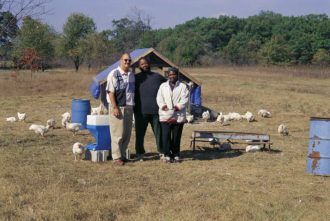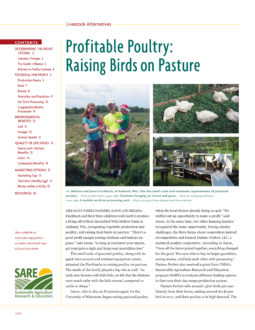Most producers find alternative poultry systems make economic sense because the cost of establishing them is low while the potential for significant and steady income is high. However, much of the growing interest is because these new systems also promote values such as family and community cohesion, environmental stewardship, working outdoors and independence for farmers.

Family and Lifestyle Benefits
When the Fischbachs started to farm, the size of their children was a concern. “We were scared that our kids could get hurt with larger animals like cattle or hogs,” said Jason, “but poultry are a more manageable, safer size,” and that gave the Fischbach family peace of mind.
Pastured poultry has also added a community dynamic to the Fischbachs' life. The co-op farm families process together, and after they are done, they gather for a picnic and watch their children play together on the farm.
Joleen Marquardt, a Wyoming pastured-poultry producer, held down a variety of jobs off the farm, but thought that she was missing out on too much of her children’s lives. She and her husband, Greg, who operate a dryland wheat farm, were juggling child care with her various jobs.
“I like to work and contribute to the upkeep of the family,” she said, “but I felt I was losing contact with the kids.” Her pastured-poultry venture changed all that.
“I kept one of my jobs because I can do it in the winter months when we can’t raise chickens outdoors, but I focus on broilers right up through Thanksgiving,” she said. She can also focus on sons James and Jordan, and daughter Jessica, because they work right alongside her now instead of waiting for her to come home from town every evening.
“That’s the biggest benefit,” Marquardt declared. “I work with my kids, and see them learn how to take care of the chickens and work with customers.”
Considering what she used to spend on babysitters and travel, “I didn’t sacrifice anything by starting this business at home.”
Marquardt’s lifestyle resembles that of many other range-poultry farmers. Some stages are so labor intensive they cannot be done alone, and families provide the most ready workforce. Children with sufficient training can handle even the most difficult parts of the process, including moving field pens or relocating larger portable shelters with a tractor. They also can help dress and package broilers, or collect and wash eggs.
Labor
Wisconsin’s CIAS researchers, tracking labor on five pastured-poultry farms, developed a model where farmers spend 20-22 hours per week handling a 1,000-bird supplementary enterprise, raising chickens from chicks through slaughter at eight to 14 weeks.
“Labor can eventually sink your business if you don’t have a plan to control it. There’s a reason why the industry went to CAFOs [Concentrated Animal Feeding Operations], and labor is a big part of that. If you’re going to raise poultry on pasture on any significant scale, you’re going to have to be efficient and automate as much as you can,” said Spencer. Automatic watering systems, storing feed in waterproof containers in the field, and maximizing the flock size according to the pasture’s capacity are just a few of the tricks producers commonly use to reduce labor.
Ohio farmer, author and lecturer Herman Beck-Chenoweth believes farmers routinely undervalue the cost of their own labor. “They should keep track of everything, from building pens to learning more about the process to marketing, and if it isn’t paying, they should do something else,” he said, adding that it is important to ask a fair price for meat and eggs while minimizing the amount of time spent on poultry chores.
The Salatins have efficiency down to a science. According to Daniel Salatin, Joel’s son and now the manager of the poultry operation, two people process 35 to 40 chickens per hour on Polyface Farm.
Community Benefits
At least six families in a traditionally low-income community in Illinois have re-charged their finances by adding range-poultry enterprises to their farms. Farmers in Pembroke Township in north central Illinois were so inspired by their experiences testing alternative poultry systems that they formed the Pembroke Farmers Cooperative to share poultry pens, a refrigerated truck, a livestock trailer and, not least, valuable production information.
Jump-started by two SARE grants (FNC99-006 and FNC99-007), awarded as part of North Central Region SARE’s efforts to target funds to underserved groups, the Pembroke farmers experimented with both free-range and pen methods. “Through this project, I learned how to raise a healthier chicken in a process that is more economically beneficial,” said Irene Seals, a producer-grant recipient. “Raising pastured poultry is now a major part of our operation.”
With help from the Kankakee County USDA-Farm Service Agency (FSA) director, they located a small-scale processor to slaughter and package their birds, complete with the co-op label. With processing secured, the families were able to sell their product within the county or, for an even better premium, in Chicago.
“It’s a system that I felt really fits their lifestyles and the community,” said Merrill Marxman, the FSA director. “We started it as a USDA outreach effort to what we saw as an impoverished community, and now the co-op has its own headquarters.”
In another long-running partnership, NCAT, Heifer International and the University of Arkansas have held pastured poultry workshops throughout the South. Hundreds of farm families have participated, many of limited resources who benefit from this relatively inexpensive way to add new revenue.
The Way family of Cecil County, Md., enjoys farming and raising livestock, from poultry to rabbits to beef cattle, on pasture. Robin Way said the family also finds merit in attracting customers from their community to experience an integrated farm.
“People are losing small, diversified farms,” she said. “We try to manage the farm like its own little community, and we invite people to come see what we do—how the animal was raised and how it’s processed. We’re proud of what we have and how we raise them.”
